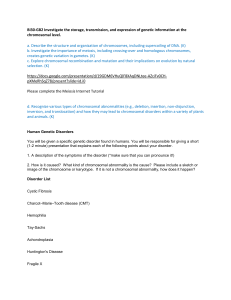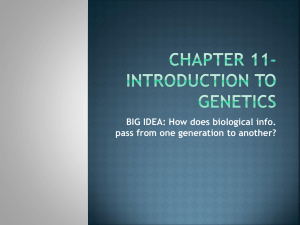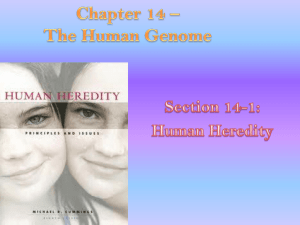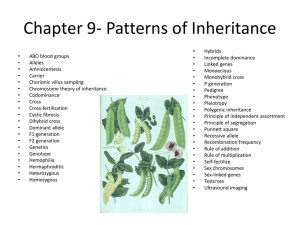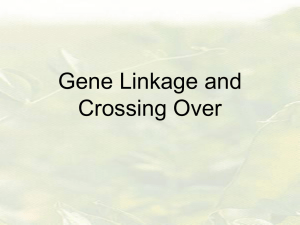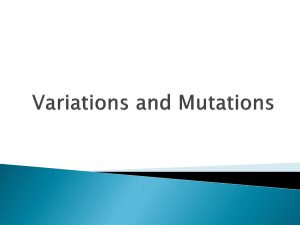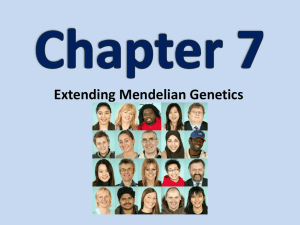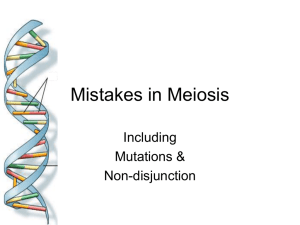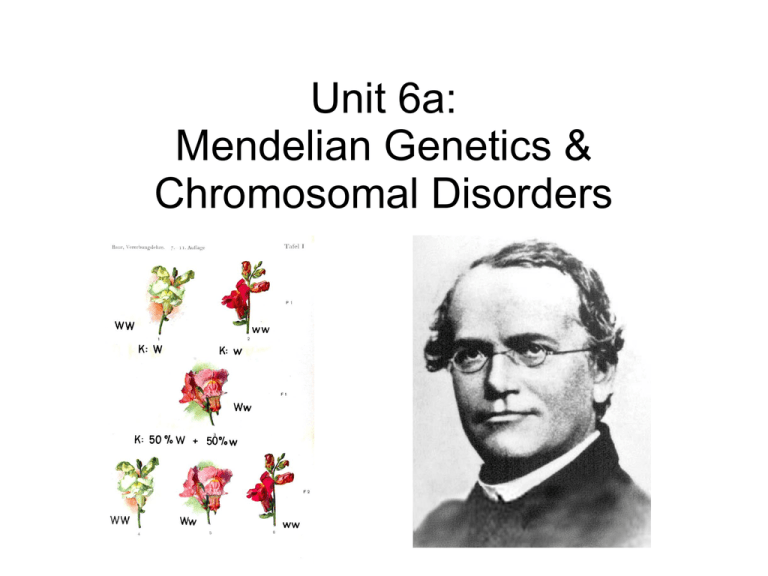
Unit 6a:
Mendelian Genetics &
Chromosomal Disorders
Gregor Mendel (mid 1800's)
Mendel's work was done before the molecular basis
of chromosomal inheritance (i.e. meiosis and
mitosis) was known.
His work formed the foundation from which
subsequent work showed that genes existed on
chromosomes and were indeed the inherited
material passed on from generation to generation.
Mendel worked with pea plants for several
reasons:
7 unique traits, most of which were “either/or” traits
(purple or white, wrinkled or smooth, etc)
Closed flowers (prevented accidental pollination)
Characters Mendel Studied:
Character – a heritable feature (e.g. flower height)
Trait – the variant for a particular character (e.g.
tall or short)
So….
True-breeding – All offspring of a given plant are the
same as the parent plant
Either homozygous dominant (YY) or homozygous recessive (yy)
Hybridization – crossing (mating) of true-breeding
varieties
P generation – parental generation
F1 generation – first generation
F2 generation – second generation
Mendel's hypothesis included the
following:
1. Alternate versions of genes (i.e. different alleles)
account for differences in inherited characters
Gene for flower color is either purple or white
2. For each character, an organism inherits two
alleles (one from each parent)
3. If the two alleles at a locus differ, one is
dominant and one is recessive:
Dominant allele – determines organism's
appearance
Recessive allele – no noticeable effect on
organism's appearance
Law of Segregation
Two alleles for a heritable character separate
(segregate) during gamete formation
Thus egg or sperm (gametes) get only one copy
Law of Independent Assortment
Each pair of alleles of a given trait sorts itself
independently of all other alleles of other traits
Occurs during metaphase I (homologous pairs of each
chromosome line up) and metaphase II (sister
chromatids of each chromosome separate) of meiosis
Homozygous – when the two alleles of a given
trait are identical (e.g. PP or pp)
Heterozygous – when the two alleles of a
given trait/gene are not identical (e.g. Pp)
Phenotype – physical trait; what you see (e.g.
purple flowers)
Genotype – genetic makeup (e.g. PP or Pp)
Example:
Pheno: purple, purple, white
Geno:
PP,
Pp,
pp
Punnett Squares
Monohybrid cross (one gene being looked at)
PP (purple) x pp (white)
(cross to F1 then cross F1 to F2)
Phenotypic ratio; genotypic ratio
Dihybrid cross (two genes being looked at)
YYRR (yellow round) x yyrr (green wrinkled)
(cross to F1 then cross F1 to F2)
Types of Inheritence
1. Complete Dominance
In the presence of at least one dominant allele,
the dominant phenotype will be expressed
Ex: Pea plant flower color
PP – purple
Pp – purple
pp - white
Non-Mendelian Types of Inheritance
2. Codominance
An equal expression of both
(different) alleles results in a
mixed phenotype
Examples:
Blood type AB (both A antigens
and B antigens are expressed on
blood cells)
Roan horses (both hair colors are
present in equal numbers)
3. Incomplete Dominance
Phenotype is a blended version
of the two alleles
Examples:
Snapdragon flowers: red (RR) x
white (rr) yield all pink (Rr)
flowers in F1 generation
Tay-Sachs disease:
2 copies of allele = death at early
age
1 copy of allele = brain cells produce
only ½ the enzyme in it's proper
form (other ½ is mutated form)
4. Multiple Alleles
A particular gene can have multiple (more than
two) but each individual only inherits two (one
from mom and one from dad)
Example:
Blood type (A, B, AB, O)
5. Sex-linked traits
A gene located on either sex
chromosome is called a sex-linked
gene (X in humans)
Sex-linked gene (on X chromosome)
Linked genes (genes that tend to be
inherited together on the same
chromosome due to their close
proximity)
Examples:
Color blindness
Hemophilia
6. Sex-limited traits
Autosomal gene is present in both sexes but
expression depends on sex of individual (it’s
dominant in one sex but recessive in the other)
Example:
Baldness in males:
Man with one copy of gene will be bald
Female needs two copies of gene to be bald
Milk production in females
Man with one copy does not lactate
Female with one copy lactates
5. Polygenic inheritance
Many traits are the product of multiple genes and
their environment
Examples:
Skin color, hair color
Many genetic disorders (e.g. autism, cancer)
Extranuclear inheritance
Some genes are passed from parent to offspring
without being part of nuclear chromatin
Mitochondria (and chloroplasts in plants) are randomly
assorted into gametes and daughter cells
In animals, mitochondrial traits are maternally inherited
Example:
Leaf color in four o'clock plants
Human mitochondrial disorders
Sex Chromosomes
In humans, X and Y are the two
sex chromosomes
In females (XX), one X is
inactivated in each cell (randomly)
In males (XY), the X from mom is
always active
X chromosome contains majority
of genetic information on sex
chromosomes; Y chromosome is
much smaller with only 70’ish
genes
Gene linkage
Genes adjacent (or close) on the
same chromosome tend to move
as a unit; these genes are often
termed “linked genes”
Probability that they will segregate
as a unit is a function of distance
between them
Mendel's laws of segregation and
independent assortment only
apply to genes on different
chromosomes! Linked genes do
not apply.
Gene Mapping based on
recombination frequencies
Given the following table, construct a simple
recombination map for the location of genes on
a particular chromosome:
P and L – 30%
L and X – 5%
X and P – 35%
M and P – 10%
X and M – 45%
Chi-squared Test
Statistical test used to compare observed data
with expected data to see if the null hypothesis
(expected data) is within an acceptable range.
Practice Problems
*See separate sheet*
Mendel's work (circa 1850) showed existence of
“hereditary factors”
Subsequent work showed these “factors” (i.e.
genes) are located on chromosomes which are
passed along from cell to cell via:
Mitosis – occurs in somatic cells; results in 2 identical
diploid daughter cells
Meiosis – occurs in germ cells; results in 4 nonidentical haploid daughter cells
Mutations
• Mutations can arise from direct damage to DNA
OR from mistakes during meiosis
• Mutations can be:
Harmful
Beneficial
Neutral
A. Mutations directly to DNA
1. Mutation(s) during replication of DNA (S phase
of cell cycle)
2. Environmental mutations carcinogens and/or
toxins in environment modify bases on DNA
strand
*In all cases, mutation will be passed on to all
subsequent cells (unless mutation is lethal)*
B. Mutations involving changes in chromosomes
1. Abnormal chromosomal
number
Results from
nondisjunction (members
of a pair of homologous
chromosomes do not move
apart properly during
meiosis II)
Aneuploidy – abnormal
number of chromosomes
Monosomic – only one copy
Trisomic – three copies
Examples
Trisomy 21 (aka Down's
Syndrome)
Klinefelter Syndrome (XXY)
Male sex organs are present but
small; male is sterile
Breast enlargement and other
female body characteristics are
often present
Turner's Syndrome (aka
Monosomy X)
Females are sterile; if given
estrogen replacement therapy,
secondary sex characteristics will
develop
2. Alterations in chromosome structure
Deletion – chromosomal fragment is lost
Duplication – chromosomal fragment is
duplicated (in tandem or in reverse)
Inversion – part of chromosome breaks, inverts
180, and reinserts itself into same place on
chromosome
Translocation – part of chromosome breaks apart
and re-inserts into another part of chromosome or
another chromosome entirely
Examples
“cri du chat” - deletion in chromosome 5
Child is mentally retarted, small head with unusually
facial features, cry like a distressed cat
Chronic myelogenous leukemia (CML) –
translocation between chrosomes 22 and 9
Cancer of bone marrow affecting young children to
young adults

